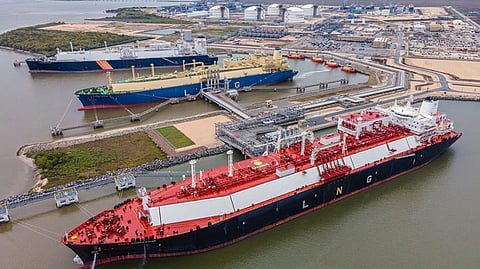US natural gas prices decline on record output, cooler weather
US natural gas futures fell about five per cent to a nine-month low on Tuesday on near-record output, ample fuel in stockpiles and forecasts for less hot weather and lower demand through early September than previously expected.
Another factor weighing on gas prices was a decline in the amount of gas flowing to liquefied natural gas export plants due to small reductions at several facilities. Front-month gas futures for September delivery on the New York Mercantile Exchange fell 12.4 cents, or 4.3 per cent, to settle at $2.766 per million British thermal units, its lowest close since November 8.
Financial group LSEG said average gas output in the Lower 48 states rose to 108.5 billion cubic feet per day so far in August, up from a record monthly high of 107.8 bcfd in July. Meteorologists forecast the weather will remain mostly near normal through September 3, which is cooler than previously expected.
Despite hotter-than-usual weather earlier in the summer, record output allowed energy companies to inject more gas into storage than usual in recent months. Analysts said there was about six per cent more gas in storage than normal for this time of year and predicted inventories would keep growing at a faster than usual pace in coming weeks.
LSEG projected average gas demand in the Lower 48 states, including exports, would ease from 110 bcfd this week to 105.7 bcfd next week. Those forecasts were lower than LSEG's outlook on Monday. The average amount of gas flowing to the eight big US LNG export plants rose to 15.9 bcfd so far in August, up from 15.5 bcfd in July. That compares with a record monthly high of 16 bcfd in April.
On a daily basis, LNG export feedgas was on track to rise to 15.3 bcfd on Tuesday from a two-week low of 14.2 bcfd on Monday due to reductions at several plants, including Cheniere Energy's 4.5-bcfd Sabine Pass in Louisiana, Cameron LNG's two-bcfd plant in Louisiana, and Freeport LNG's 2.1-bcfd plant in Texas.
The US National Hurricane Center (NHC) projected Hurricane Erin, which was near the Bahamas, would move north and then east off the US East Coast for the rest of the week without hitting land. The storm, however, could cause some tropical storm force winds in eastern North Carolina on Thursday.
The NHC said another system in the Atlantic Ocean behind Erin had a 60 per cent chance of strengthening into a cyclone over the next week as it moves west toward Puerto Rico and the Bahamas.
Even though storms can boost gas prices by knocking Gulf of Mexico gas production out of service, analysts have said storms are more likely to cut demand and prices by shutting LNG export plants and knocking power out to millions of homes and businesses, reducing the amount of gas that electric generators need to burn.
Only about two per cent of all US gas comes from the federal offshore Gulf of Mexico, while more than 40 per cent of the electricity produced in the US comes from gas-fired power plants.
(Reporting by Scott DiSavino in New York; Editing by Sharon Singleton)


